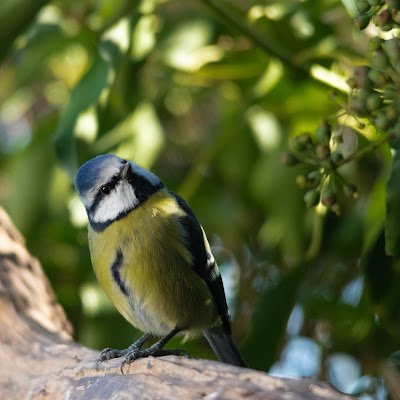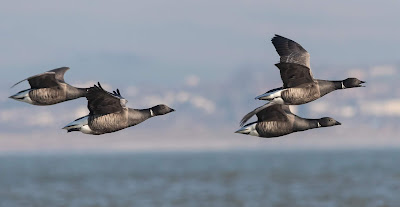Tuesday, 5 August 2025
Monday, 8 April 2019
January - 2019 - March
The first quarter of 2019 has brought both surprises and rewards, with crisp winter days and unseasonably warm periods creating the perfect conditions for wildlife and watcher alike.The Sanctuary's Big Garden Birdwatch was counted on a brisk Monday morning, with a dusting of snow on the surrounding hills. The air was fresh, the sky was winter blue, and the vibrant sun shone life into the day; as illustrated by the constant distraction of bird-flight. Winter was at its most welcoming and the wildlife community appeared vital and busy.
Despite the favourable conditions, the starlings and meadow pipits were missing for the second consecutive year, while the frequently represented goldcrests also failed to make an appearance. Perhaps the most notable absentees were the pigeons and thrushes. Although there were plenty of woodpigeons and the odd collared dove to be appreciated outside of the allocated hour, the same could not be said for the thrushes.
On a positive note, the chaffinches were out in significant numbers and proved to be the most abundant species of 2019. The distinctive sounds of a nuthatch's knock and a woodpecker's drill could both be heard before each came into view, making the list for the first time since 2016. As ever, the blue tits, sparrows and dunnocks didn't disappoint.
Chaffinch (Fringilla coelebs)
A male chaffinch flies past a singing female.
As noted in previous years, this periphery tree proved to be a busy station between the Sanctuary and the surrounding woodland, with tits, wrens, robins and sparrows all exploiting the tangle of skeletal branches. It is the perfect platform to rest or simply observe the environment.
As noted in previous years, this periphery tree proved to be a busy station between the Sanctuary and the surrounding woodland, with tits, wrens, robins and sparrows all exploiting the tangle of skeletal branches. It is the perfect platform to rest or simply observe the environment.
Monday 28th January
Birds
27 Chaffinch (Fringilla coelebs)
09 Jackdaw (Corvus monedula)
08 Mallard (Anas platyrhynchos)
08 House sparrow (Passer domesticus)
06 Black headed gulls (Chroicocephalus ridibundus)
05 Blue tit (Cyanistes caeruleus)
04 Blackbird (Turdus merula)
04 Dunnock (Prunella modularis)
04 Carrion crow (Corvus corone)
03 Wren (Troglodytes troglodytes)
03 Robin (Erithacus rubecula)
03 Long tailed tit (Aegithalos caudatus)
03 Coal tit (Periparua ater)
02 Magpies (Pica pica)
02 Nuthatch (Sitta europaea)
01 Great tit (Parus major)
01 Great spotted woodpecker (Dendrocopos major)
01 Red kite (Milvus milvus)
01 Moorhen (Gallinula chloropus)
Mammals
02 Grey squirrels (Sciurus carolinensis)
Blue tit (Cyanistes caeruleus)
With colours that transcend the frequent perception of native birds
House sparrow (Passer domesticus)
In recent decades, the population of house sparrows has declined by as much as 60% (RSPB). Fortunately, they are a consistent presence at the Sanctuary.
In recent decades, the population of house sparrows has declined by as much as 60% (RSPB). Fortunately, they are a consistent presence at the Sanctuary.
Dunnock (Prunella modularis)
A specialist and durable ground feeder.
A specialist and durable ground feeder.
Greater spotted woodpecker (Dendrocopos major)
During the summer months when the foliage is rich and green, the surrounding woodland hides its secrets well. However, the leaf-bare trees of winter are not so discreet and provide a much better opportunity to spot its inhabitants, especially those betrayed by a distinctive colour.
Wren (Troglodytes troglodytes)
While only three wrens were counted at any one time during the survey, there did seem to be at least one present in every emerging group of birds.
Scuttling around, full of energy, it was probably the smallest and busiest species of the day.
Moorhen (Gallinula chloropus)
Over the coming weeks and months, the moorhen population around Baboon Island will doubtless double twice, depending on the success of mating and rearing of young. No matter what the future holds, it seems at least one moorhen is guaranteed to remain throughout the winter months.
Female mallard (Anas platyrhynchos)
Male mallard (Anas platyrhynchos)
Generations of mallards have made their home around Baboon Island, which means there are usually ducklings around come spring.
Jackdaw (Corvus monedula)
The jackdaws have a 'waste not - want not' policy when it comes to food, and make the most of the morsels dropped by the resident hamadryas baboons. This has now become a well established practice and can descend in significant numbers when the baboons are not present.
Black-headed gull (Chroicocephalus ridibundus)
The only gull to be represented at this year's count, with six sounding like sixty.
The following week's temperatures dropped further, leaving the mornings coated with ice. On one such day, I took a cautious stroll along the local canal, just a few miles south of the Sanctuary. As I walked, my attention was drawn towards a cat on the opposite bank; its concentration focused on movement amongst the water's vegetation. At first I assumed it was one of the plentiful mallards that had caught its eye, or maybe an injured bird struggling to escape the reeds and freezing water, but as I looked closer the otter came into focus.
Even in winter, natural light along the canal is restricted by overhanging trees, but I crouched onto the floor in an attempt to photograph something of the unfolding scene: it seemed the otter's route to the bank was cut-off by the resident moggy. After a few moments of unfruitful negotiation, the otter retreated to another section of the bank and made its escape through the foliage.
Otter (Lutra lutra)
Witnessing the otter was particularly uplifting given their apparent absence from the adjacent river in the last couple of years, and I have never before seen one on the canal. I don't know whether its presence was related to the impact of winter, but there is nothing quite as rewarding as an unexpected wildlife encounter.
Moments later, as I walked fifty yards or so up the canal, a cormorant floated by with a look of curiosity that hinted at disgust. Though somewhat dowdy in the feather, this bird is anything but dull. Its strong colours are concentrated in the face, and brighten an otherwise severe set of features, while its hooked bill draws the eye from the slender, sponge-like neck.
With such an impressive wingspan in flight, the cormorant cuts an imperial, gothic-like figure when posed for drying. Cormorants are neither rare or endangered in the UK, and over the first few months of this year I have witnessed a number on the river, canal and Loughor Estuary. But moments after the aforementioned sighting on the canal, I am reminded of their vulnerability, when a stranger feels the need to approach and express his desire to shoot the animals that are taking the fish from the canal.
Cormorant (Phalacrocorax carbo)
Defiant, proud and vulnerable
A couple of days later, just a little further along the canal, I was surprised to see a bat emerge into the February daylight. Clearly disturbed from its roost, I watched the bat for five to ten minutes, failing to photograph its erratic flight pattern, when a pigeon appeared from a nearby tree.
Between the speed of the pigeon's take-off and the clumsy turn of the bat, the impact into the pigeon's chest was hard and conclusive. While the pigeon continued regardless, the stunned bat seemed to pause in mid-air for the briefest of moments before dropping like a stone. I searched the canal verge, where the bat looked to have landed, but it seems likely the unfortunate displaced mammal ended up in the canal.
The grey heron is a familiar sight on Welsh waterways, fishing for food in the shallows. They can be seen along the Nant llech and River Tawe, both of which merge behind the Sanctuary.
Grey Heron (Ardea cinereal)
Wales is home to a diverse range of wildlife, much of which is easily accessible. South of the Sanctuary, the Tawe's riverside path offers a meandering walk through to Swansea Bay, and a guaranteed view of herons, dippers, goosanders and wagtails. Though not a stranger to rivers, this year was the first time I have seen a little egret on this stretch of river.
Little egret (Egretta garzetta)
The little egrets appear to be doing well in this part of the world, particularly on the Loughor Estuary, where a mix of fascinating waders congregate. While sharing similar characteristics to the grey heron, it is a much smaller species and therefore appears more graceful on take-off and landing.
The estuary is a beautiful and fascinating location to appreciate wildlife, and enjoy local species you might otherwise never see, but it can also be brutally cold, particularly when exposed to the cutting, winter winds.
The tide recedes to reveal the scar of human influence.
Little Egret (Egretta garzetta)
Kestrel (Falco tinnunculus)
A kestrel flying over the Loughor Estuary, a familiar sight along the South Wales coast.
A kestrel flying over the Loughor Estuary, a familiar sight along the South Wales coast.
Yellowhammer (Emberiza citronella)
It's always nice to see a new species and a walk along the Burry Port side of the Loughor Estuary presents my first yellowhammer.
Winter can be the best time to visit the estuary and the coastal paths that lead west to Llanelli and Pembrey Country Park, and south toward Gower. The Llanelli Wetland Centre is also very enjoyable. Fortunately, February brought several warm and sunny days with which to experience the visiting winter birds mingle with the resident species.
Redshank (Tringa tetanus)
The estuary presents the perfect conditions for long billed specialists like the redshanks, godwits, oystercatchers, curlews and dunlins, all of which feed on the insects, molluscs, worms and crustaceans found deep in the earth, mud and sand.
Black-tailed godwit (Limosa limosa)
With February masquerading as June, I took a walk down to Gower's Cwm Ivy woods and Whiteford Burrows, making the most of the available hides and sharing the marshes with the grazing wild horses.
The wild horses of Gower
Shelduck (Tadorna tadorna)
The shelducks are a familiar sight on and over the marsh.
Walking back along the beach, a significant flock of oystercatchers descended on the shoreline rocks, outnumbering the already integrated curlews, plovers, dunlins, godwits and brent geese. The plovers and dunlins, in particular, have an incredible knack of disappearing into their surrounding pebbles and rocks.
Oystercatcher (Haematopus ostralegus)
Oystercatchers (Haematopus ostralegus) and Curlews (Numenius arquata)
Curlew (Numenius arquata)
Ringed plover (Charadrius hiaticula)
Lapwing (Vanellus vanellus)
Brent Goose (Branta bernicla)
Eider Duck (Somateria mollissima)
As I continued my walk along the beach, I came across a large grey seal sunbathing on the sand. Its eyes remained focused on my movements as I stopped to take a photograph, then risk assessed my presence and shuffled back into the sea. It was only when I saw the seal relatively close and out of the water that I appreciated the significant size of its body, compared to its frequently seen head.
Somewhat curiously, the seal remained with me for the next twenty minutes or so, diving from view before reappearing just ahead, monitoring my actions from the water, where it clearly felt more comfortable and confident. It was a truly wonderful encounter.
Grey seal (Halichoerus grypus)
And then it is April. And springtime.
Labels:
Big Garden Birdwatch 2019,
Canal,
Cormorant,
Cwm Ivy Woods,
Gower,
Otter,
RSPB,
Seal,
Swansea,
Wales Ape and Monkey Sanctuary,
Whiteford
Location:
Wales Ape and Monkey Sanctuary
Subscribe to:
Comments (Atom)























































